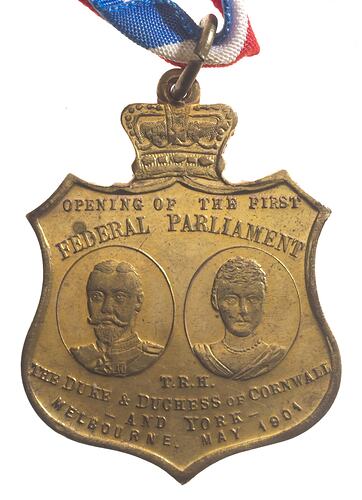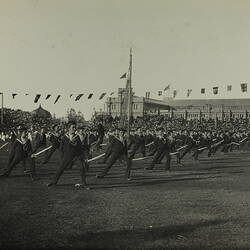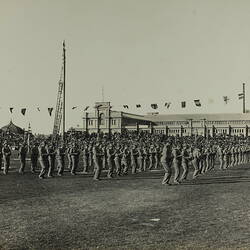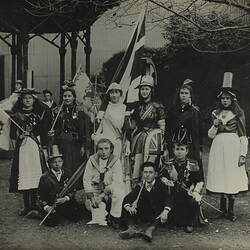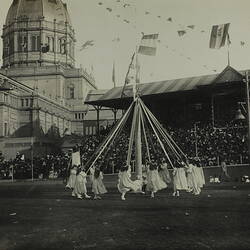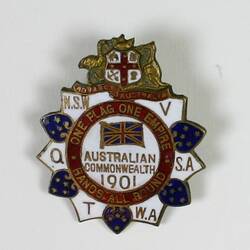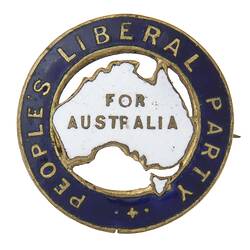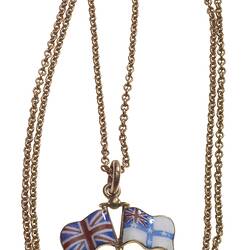Summary
The Commonwealth of Australia was inaugurated on 1st January 1901 in Centennial Park, Sydney. In March, elections were held for the new Federal Parliament, and in May the celebrations focused on Melbourne, where the first Federal Parliament was opened in the (Royal) Exhibition Building. This narrative describes the role young people played in Federation celebrations.
'...remember longest the stirring historical events of the past few days. Many of you may by your lives and example influence the growth and development of the Commonwealth whose birth you have witnessed.' (Duke of Cornwall and York to school students, 14 May 1901)
Australia becomes a Nation
Australia officially became a nation at a ceremony in Sydney on 1 January 1901. With the focus on Sydney the celebrations in Melbourne were restrained, but a number of Victorian towns and suburbs organised local events at which the younger members of the community usually played a role.
Towns along the Victorian/NSW border celebrated the end of intercolonial tariffs. Processions from Echuca and Moama met in the middle of the connecting bridge, symbolising the union of Australia (Riverine Herald, 2 January 1901, p2). The Echuca procession included local cadets, and a 'beautifully decorated wagon bearing six young girls representing the Federating States'. In Wodonga, there was a procession of 300 'bright looking and well-dressed children [carrying banners with]...loyal and patriotic mottoes'. The local newspaper called them 'the men and women of the future'.
Some communities, such as Port Fairy and Morea, gathered at their local school for a flag ceremony followed by a large picnic (Horsham Times, 4 January 1901, p3). Other towns gave their annual New Year's Day picnic and sports afternoon a Federation focus. In Wangaratta and Essendon school students were presented with commemorative certificates.
Victoria and the First Commonwealth Parliament.
In May 1901 the Duke and Duchess of Cornwall and York visited Melbourne to open the first Commonwealth Parliament. School holidays allowed students, including those visiting from regional areas, to join crowds in the city for the two weeks of celebrations. They watched the processions, listened to bands, and witnessed streets and buildings dressed with an impressive array of banners, flags, decorative lights and elaborate ceremonial arches.
The royal couple landed at St Kilda on 6 May. More than 30,000 Sunday School students and teachers greeted them by singing the specially written 'Australia's Welcome' (Weekly Times, 27 April 1901, p23). It was 'a sight not to be forgotten, the various colors worn and the waving of flags presented a handsome spectacle' (Moorabbin News, 11 May 1901). Larry Brumley, a boy from the Omeo district, organised his own greeting. He sent a telegram saying, 'Welcome to Australia; hope you will enjoy yourselves' (The Omeo Standard, 10 May 1901, p2).
Isolated from Melbourne, Mildura held its own 'Federal Day' celebrations on 9 May, the day Parliament opened. Five hundred 3-15 year olds marched through the streets waving small flags, sang the National Anthem and gave cheers for the Federal Parliament. At a picnic and sports afternoon they were given a small bag of lollies and a commemorative badge featuring the Governor-General, the Duke, the Duchess, or the late Queen Victoria (Mildura Cultivator, 4 May 1901; 11 May 1901).
Raising the Flag
From Warrnambool to Wahgunyah, Mildura to Maffra, Dimboola to Delegate River, and throughout the suburbs of Melbourne, Victorian students joined in a ceremony on 14 May to simultaneously raise the Union Jack. Around Australia an estimated 650,000 students at 7000 schools took part (Education Department 1901, p144).
The flag-raising ceremony followed a prize presentation to public school students at the Exhibition Building. At 12.50pm the Duchess pushed a button to send the telegraphic message 'hoist' all over Australia and to London, New Zealand and Fiji (Education Department 1901, p144). In some towns, gunshots or fire-bells were used to signal the school when the message was received.
Typically, each school chose a student to raise the Union Jack while others waved small flags. The local cadet corps fired a volley and the crowd joined in singing the national anthem, 'God Save the King'.
Many Victorian towns and suburbs planned their local Federation event around the flag ceremony. Some schools distributed cakes, lollies and fruit to the students before granting a half-holiday. Others communities held luncheons, picnics and sports afternoons. In the evening, children and adults alike performed in concerts, took to the dance floor and marvelled at fireworks.
In some areas, such as Broadford and Tullamarine, the flag ceremony was held on a different day to ensure it was a community event (Essendon Gazette, 2 May 1901).
Other events
The State Schools' Demonstration on 11 May was described as 'one of the most interesting fixtures in the official programme' (Gippsland Farmer's Journal, 14 May 1901, p2). 10,000 students from 57 Metropolitan schools participated, including a choir of over 5,000 students dressed in red, white and blue. Others created patriotic scenes and gave displays of physical exercises and military-style drills. Costumes added to the impact of maypole, flower and Highland dances. The Age called the performance 'a work of art, a monument to discipline, and a living lesson as to the capacity of 'the nation of to-morrow' (The Age, 16 May 1901).
On 7 May the Chinese Procession included young girls riding ponies (Wangaratta Dispatch, 11 May 1901; Riverine Herald, 10 May 1901), and at the Royal Review on 10 May, 5000 Victorian cadets marched past the Duke. One of the royal escorts declared 'everyone...voted that the best part of the review, the most novel, and the most impressive' (Argus quoted in Bairnsdale Advertiser, 16 May 1901).
For some, all the excitement was too much. One boy was heard to say 'Royalty! I'm sick of Royalty! Ain't seen nothing else the whole blessed week. I'm going to bed!' (Bendigonian 14 May 1901, p15).
When the Duke and Duchess travelled by train to Geelong, Ballarat, Healesville and Sale, crowds gathered at stations along the line to greet them. Students formed guards of honour and sang the National Anthem. In Rosedale, cadets fired a salute fired which the Gippsland Farmers' Journal thought all the more worthy because it 'arose from the spontaneous enthusiasm of the boys themselves' (Gippsland Times, 20 May 1901, p3; West Gippsland Gazette, 21 May 1901, p2; Gippsland Farmers' Journal, 17 May 1901, p2).
Victorians who farewelled the royal train as it travelled from Melbourne to Wodonga ranged from large crowds and school groups at elaborately decorated stations, to a mother and two small children at an isolated platform (Bairnsdale Advertiser, 21 May 1901, p2 ).
The new nation
The young people of 1901 experienced the introduction of Federation. As they grew into adulthood they participated in helping to shape Australia. Some fought in World War I, an event which is sometimes said to have 'forged the nation'.
References
The Royal Visit: State Schools' Demonstration', The School Paper for Classes V. and VI., Education Department, Melbourne, June 1901, Vol.III, No.32, p144.
More Information
-
Keywords
-
Authors
-
Article types
